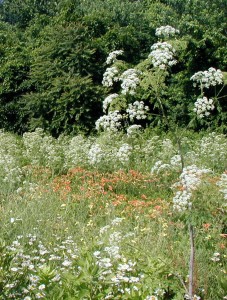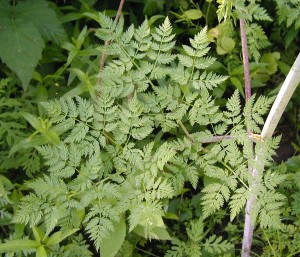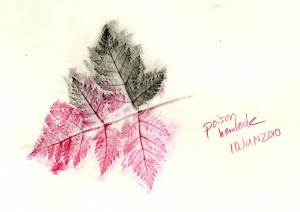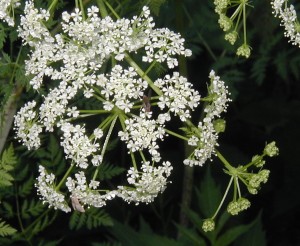From the end of May and for nearly the whole month of June we kept seeing this tall flowering weed everywhere. It pops up in fence rows, empty fields, along the highway, near the river and in waste areas.
It’s a tall plant that reaches 4-8 feet tall, with a few individuals getting up to 12 feet tall. This weedy alien plant blooms for a few weeks with very small white flowers in rounded clusters or umbels.
One day while traveling down a country road, I asked my friend to pull over so I could get a closer look at this flowering roadside weed. Since there were so many of these plants in many places I yanked one up to bring it home for a better look. When I brought it back to the car my driver said, “Hey, don’t bring any poisonous stuff in here!” I’m not sure why that was said as I have littered the car with plant specimens many times before, so I retorted with a quick, “Of course, not!”
After arriving home I consulted Newcomb’s Wildflower Guide to identify the roadside weed. Well, luck would have it that the flowers with five parts, having alternate, divided leaves, and white flowers in umbels indicated this weed to be Poison Hemlock, Conium maculatum. OMG! When I asked my friend why she said what she said, she replied, “It just looked like poison!”
I have to admit the whole plant had this wierd smell. It was a funky smell that might be described as acrid or dank, kind of like wet dirty socks. A week later I stopped at a parking lot to get some pictures of the weed. Where the edge of an empty field met the gravel of the parking lot, the Poison Hemlock grew prolifically there. The smell was undeniable.

Phew! No wonder flies pollinate this stinky stuff!

Several umbels are already setting seed while other umbels are blooming.

In the photo above the foreground flowers are oxeye daisies and the white flowers in the background are poison hemlock.
The smell alone should alert anyone that this plant shouldn’t be ingested, but every year several people try it anyway. Why anyone would think a white and purple blotched “carrot” is an edible one is the mystery. We all know their tap roots are orange!
Cohorts of poison hemlock at the parking lot were sumac, daylilies, oxeye daisy, purple loosestrife, nightshade, blackberries, common mullein and crown-vetch.
The large compound or divided leaves appear rather lacy or fern-like and they clasp the main stem, sheathing it. Purple blotches or spots are highly visible on the substantial stems, especially at the base. This plant may look sort of like wild carrot, but the tap root is white with purple spots and streaks, not orange. Do not attempt to eat any Parsley Family members without assured identification. Death may result!




Photos taken 10 June 2010.
The small bracts underneath the umbels are entire. Another member of the Parsley Family, Wild Carrot or Queen Anne’s Lace, Daucus carota, has divided bracts that are deeply and narrowly lobed.
If you remember your history lessons, poison hemlock was used to kill the famous philosopher Socrates back in ancient Athens. A very small amount ingested can cause death. Take caution and realize that the juice from the plant can cause dermatitis. I didn’t suffer any rash or itching after I handled it, but some people might be sensitive to it. Do not handle if at all possible. If pulled up, use gloves and do not put in compost heap or the seeds may come back to haunt you. Dispose in plastic bag in the garbage.